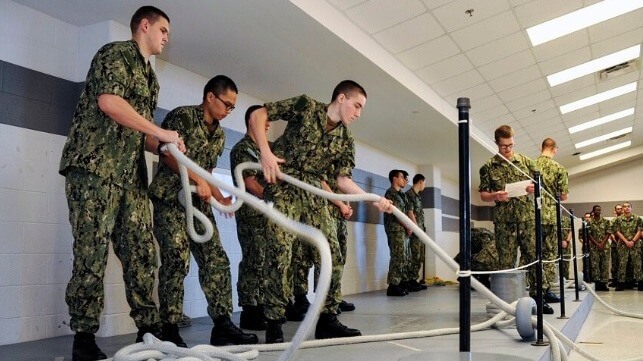U.S. Navy On Track to Miss Recruitment Goal by 7,000 Sailors

The U.S. Navy has been working hard to head off a massive shortfall in its recruiting numbers, and by some measures it is succeeding, the service's acting top officer told Congress on Thursday.
In a hearing before the Senate Armed Services Committee, Acting Chief of Naval Operations Adm. Lisa Franchetti said that the Navy is currently on track to undershoot its annual target by about 7,000 recruits. This is more than the 6,000-recruit shortfall that Franchetti predicted in April, but she told lawmakers that internally, the Navy had been concerned at the possibility of a deficit of as many as 13,000 new sailors. 7,000, by comparison, would not be as damaging.
The Navy has pulled out all the stops in an attempt to onboard more new hires. It has eased its testing standards to the minimum level allowable by law, maximized its eligible recruitment age, added a coaching program to help low-performing recruits, and launched a pre-boot camp fitness regimen for those who need assistance meeting weight requirements. New incentives have been created to entice promising candidates, like a $35,000 bonus for shipping out quickly. For a brief period, Navy recruiters were pressed into a six-day work week (quickly repealed).
The structural difficulties are harder to fix. Only 23 percent of Americans aged 17-24 meet the criteria for service, according to the Pentagon. Criminal records and test scores hold up some; fitness is an impediment for many.
Others are getting caught up in the medical screening process. The service's medical records platform, Military Health System Genesis, pulls all of a recruit's past medical history - often forcing a protracted process to obtain medical waivers for old conditions. In years past, a candidate could have left a potentially disqualifying condition off the screening form and entered the service, but this is no longer possible.
According to the chief of naval personnel, Vice Adm. Rick Cheeseman, the average time it takes for a recruiter to get an applicant from first interview to signing a contract has nearly doubled since Genesis went into operation, rising from 33 days to 63.
Delays at the top
The Navy also has a serious personnel challenge at the very top. Acting CNO Adm. Franchetti is just one of dozens of recently-selected admirals awaiting confirmation by the Senate, and the holdup is damaging readiness, she said Thursday.
Promotions and appointments for generals and admirals are usually uncontroversial and pass the Senate by voice vote. This year, that process has been upended: Sen. Tommy Tuberville (R-AL) has put a blanket hold on the votes unless the Pentagon stops reimbursing servicemembers for travel expenses they incur in obtaining an abortion. The hold has been in place since March, leaving about 300 admirals and generals awaiting confirmation across the armed forces.
In the Navy, the consequences are tangled. The role of Commander of Naval Air Forces is being filled by the admiral who is supposed to be running U.S. 5th Fleet, while the actual nominee for the post awaits Senate confirmation of his third star. The heads of Naval Sea Systems Command, Naval Surface Forces, Naval Installations and the U.S. Naval Academy are all currently filled on an acting basis, according to USNI.
On Thursday, Adm. Franchetti said that the impact would be felt for a long time.
“Just at the three-star level, it would take about three to four months just to move all the people around. But it will take years to recover . . . from the promotion delays," she testified.
